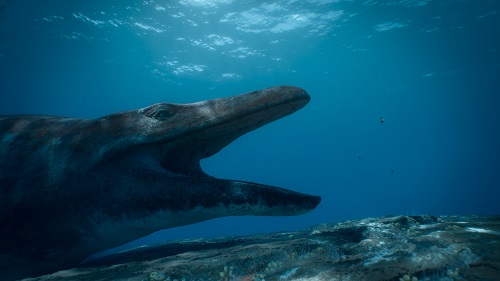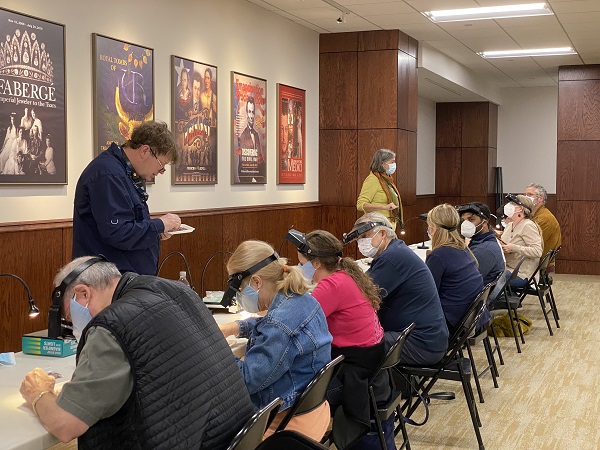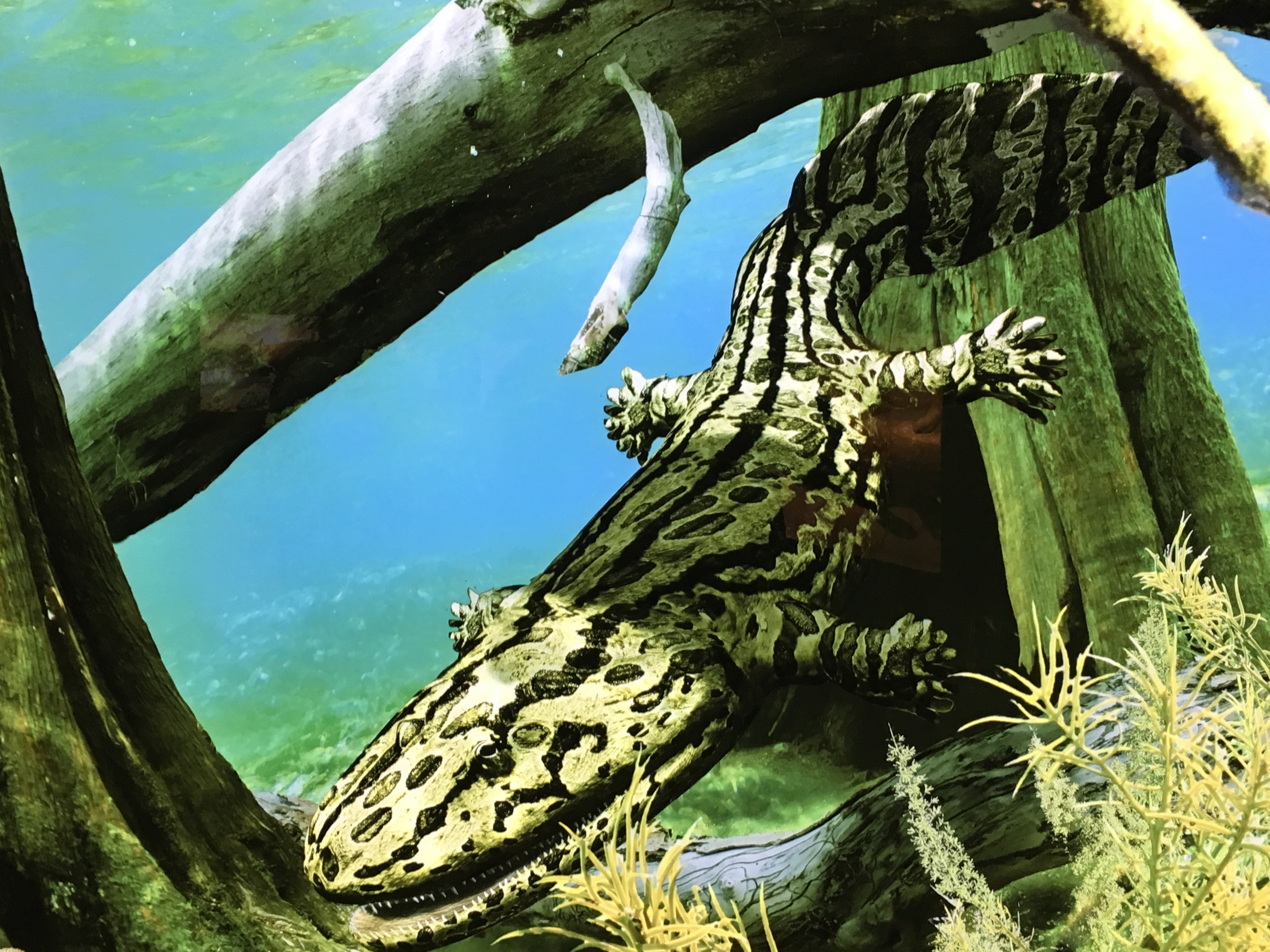The visit to our active digs at the Craddock Ranch red beds exhausted Kelly and I, but it was fascinating to learn how the Houston Museum of Natural Science discovers, jackets and moves its Permian fossils to our lab. The second day, we lent a hand at the Whiteside Museum of Natural History in Seymour for their one-year anniversary celebration. I conducted interviews with Museum Director Chris Flis, our associate paleo curator David Temple, and a handful of Seymour residents, while Kelly shot photos, posted Tweets and produced Periscope videos.

The Whiteside Museum of Natural History in Seymour, Texas has the potential to breathe new life in to the city through historic ecotourism. Jason Schaefer.
The Whiteside has the potential to bolster Seymour’s dwindling economy through historic ecotourism. Locals want to keep Baylor County fossils at home, housed in a single facility, in hopes that visitors will spend a weekend and their money in the shops, restaurants and hotels of the dusty Texas town. Dimetrodon has the potential to attract paleo-fans and academics alike from far and wide and give Seymour a new brand as the home of the richest Permian fossil accumulations in the world. It has been known as such unofficially for nearly 100 years.
Flis, Temple, and paleo curator Dr. Robert Bakker, who arrived in Seymour the previous night, regard the Craddock bone bed as crucial in the understanding of some of the most important enigmas of modern paleontology. In the past century, the information unearthed from the caked deposits of these ancient rivers has answered many questions about Permian ecosystems. However, with each layer removed, new riddles emerge. How many species of Dimetrodon were there? Why did they live so far away from the swamp, where the herbivorous Edaphosaurus lived? Shouldn’t Dimetrodon have preyed on Edaphosaurus? Should Dimetrodon be considered a mammal ancestor? And, perhaps the most fascinating, why are there more carnivores than herbivores buried here? Paleontologists are certain the story is in the bones, and for this era, there’s no better place to find them.

At the Whiteside Museum of Natural History, Dr. Robert Bakker puzzles over the broken shin bone of a Diadectes, a rare Permian herbivore. Kelly Russo.
The exposed Permian landscape from north Texas into southern Oklahoma dates back about 290 million years. To the southeast of Seymour, the rocks get a little older, providing samples from the Pennsylvanian era, about 310 million years ago. The landscape grows younger as you travel west out of Baylor County, then ages again in eastern New Mexico about 100 miles away. Here, paleontologists have found other Permian-era sites that extend as far as Arizona, Flis explained.
“Those sites are well-known for trackways, but they’re not well-known for bones,” Flis said. “For bones, Texas is the best.”

Jacketed lumps of earth lining the wall of the Whiteside Museum of Natural History contain not only fossil specimens, but valuable information about Permian ecosystems. Jason Schaefer.
The soil is rich with exposed Permian fossils. Visitors can walk across the landscape and happen upon excellent specimens of vertebrae, joints, and bits of Dimetrodon’s famous fin spines right at their feet. The bones are preserved so well in the clay soil, they still carry their indigo luminescence when turned in the sunlight. These aren’t mineralized bones, but the real thing. They are the actual mummified parts of animals that human hands have never moved, that haven’t been exposed to light or air since their deaths.

The Craddock red beds are rich with outstanding bone fossils, nearly half of them crushed, broken or bearing tooth marks from Permian-era violence. This fragment of Dimetrodon rib could tell paleontologists more about how the reptile lived than a complete skeleton. Kelly Russo.
It’s not just the bones or their ubiquity in the red beds that makes the Craddock so valuable. It’s the story the bones tell in pieces. A perfect skeleton is great for anatomy, but for information about ancient ecosystems, the pulverized fragments are pay dirt. Paleontologists learn much more about the interaction between extinct species from bones damaged by chewing or some other trauma than from bones unscathed. There’s no story in a complete skeleton.
“You don’t know how it died. You don’t know who chewed it,” Bakker said. “It tells you nothing.”
When Bakker and HMNS teams first began digging at the Craddock about 11 years ago, he was looking for shed Dimetrodon teeth, he said, knowing that losing teeth was common for the reptile. He didn’t expect as many as he found.
“There were shed teeth everywhere,” Bakker said. “It was like a Civil War battlefield that souvenir hunters hadn’t gone over.”

The Whiteside Museum of Natural History is outfitted to prepare its own fossils with its own lab. Volunteer Dr. Mitch Fruitstone removes sedimentary rock from a fossilized jaw specimen. Jason Schaefer.
The team estimated less than five percent of the specimens would be chewed and have tooth marks. After all, T. rex swallowed his prey in chunks, tearing flesh from their bodies without much mastication. From what he’d learned from his predecessors, Bakker expected the same of Dimetrodon. However, the bones were marked in high frequency, about 45 percent, and some were chewed to pieces.
“This means Dimetrodon wasn’t chewing like a dinosaur. It was chewing like a wolf or a hyena,” Bakker said. “That’s the most surprising thing. That’s a way primitive guy, but it’s chewing like an advanced mammal predator. … Our group is the first to document that.”
Through observations made at the Craddock, these discoveries broke open new possibilities for the life of Dimetrodon and the Permian world in which it lived. It could be an ancient relative of mammals instead of reptiles. As a cross-section of the development of life on Earth, the Permian represents the dawn of land-dwellers, when amphibians first began to crawl out of the water. The link between amphibians and reptiles was discovered in the Craddock in 1904, putting Seymour on the paleontological map. Named Seymouria baylorensis to pay homage to its home town, it contended with gravity better than its amphibious predecessors 20 million years earlier, and had other adaptations that allowed the species to succeed in the dry Permian landscape.

Volunteer Dr. Mitch Fruitstone demonstrates precision fossil preparation as a child looks on during the Whiteside Museum of Natural History’s first anniversary celebration. Jason Schaefer.
Now, a model of the animal occupies a hallowed space in the Whiteside, a shining example of the value of this area to the study of the Permian. As Baylor County digs continue, paleontologists layer details about the past with each layer of soil removed: microfossils, traces of flesh-eating arthropods and fossilized pollen grains, and what appears to be different species of Dimetrodon or perhaps just male and female aspects. Bite marks and stab wounds from Xenocanth suggest the ancient shark preyed on Dimetrodon from the water while it hunted the shark from land. With each shovel of soil and swing of the pickaxe, more comes to light about Eryops, Diplocaulus, Trimerorachus and Edaphosaurus.
For the agricultural residents of Seymour, the science could spell success for a struggling community. A contract with the landowners ensures the fossils excavated from the Craddock will remain in Texas, and most of them at the Whiteside. According to Bakker, having a municipal museum is “a huge game-changer” for Seymour, for HMNS and for the state.

Dr. Robert Bakker uses his sketching skills to teach children about Dimetrodon. “Science should make you giggle,” he told the kids. Jason Schaefer.
“Our hope would be that the Whiteside would be a locus not for just digging local fossils but for teaching short courses, especially for teachers so they have hands-on experience digging fossils,” Bakker said. “We’ll take them out and they’ll go back to their classroom and show how fossils are dug.”
The building itself is not without its own history. A renovated Chevrolet dealership, it was handed down from former owner Gene Porter Robinson, who had sold cars out of the building since the 1950s. As Chevy went corporate, Robinson kept the business open, remaining active until 2001 as one of the last remaining independently-owned dealerships in the franchise.

Judge Clyde Whiteside of Baylor County, and the namesake of the Whiteside Museum of Natural History, sits beside models of Edaphosaurus and Dimetrodon during the museum’s first anniversary celebration. Jason Schaefer.
When Robinson died, Judge Clyde Whiteside recognized the value of the lot, and cherishing his friendship with Robinson, decided to purchase the half-block with the clear intent of turning it into a museum to re-invigorate the community.
“I bought my first car right here,” Whiteside said, seated in his wheelchair beside the first Dimetrodon model display. “Hopefully this will bring people back. … Now that we’ve got this interest in [the Craddock], we’ve got five active digs going, and we’re finding stuff you wouldn’t believe! I’m not a scientist, I’m a lawyer and a farmer. But it’s working, and I’m thrilled to death by it. It makes my life worth living.”
Author’s note: This is the second part in a series detailing the HMNS excursion to the Craddock Bone Bed.







